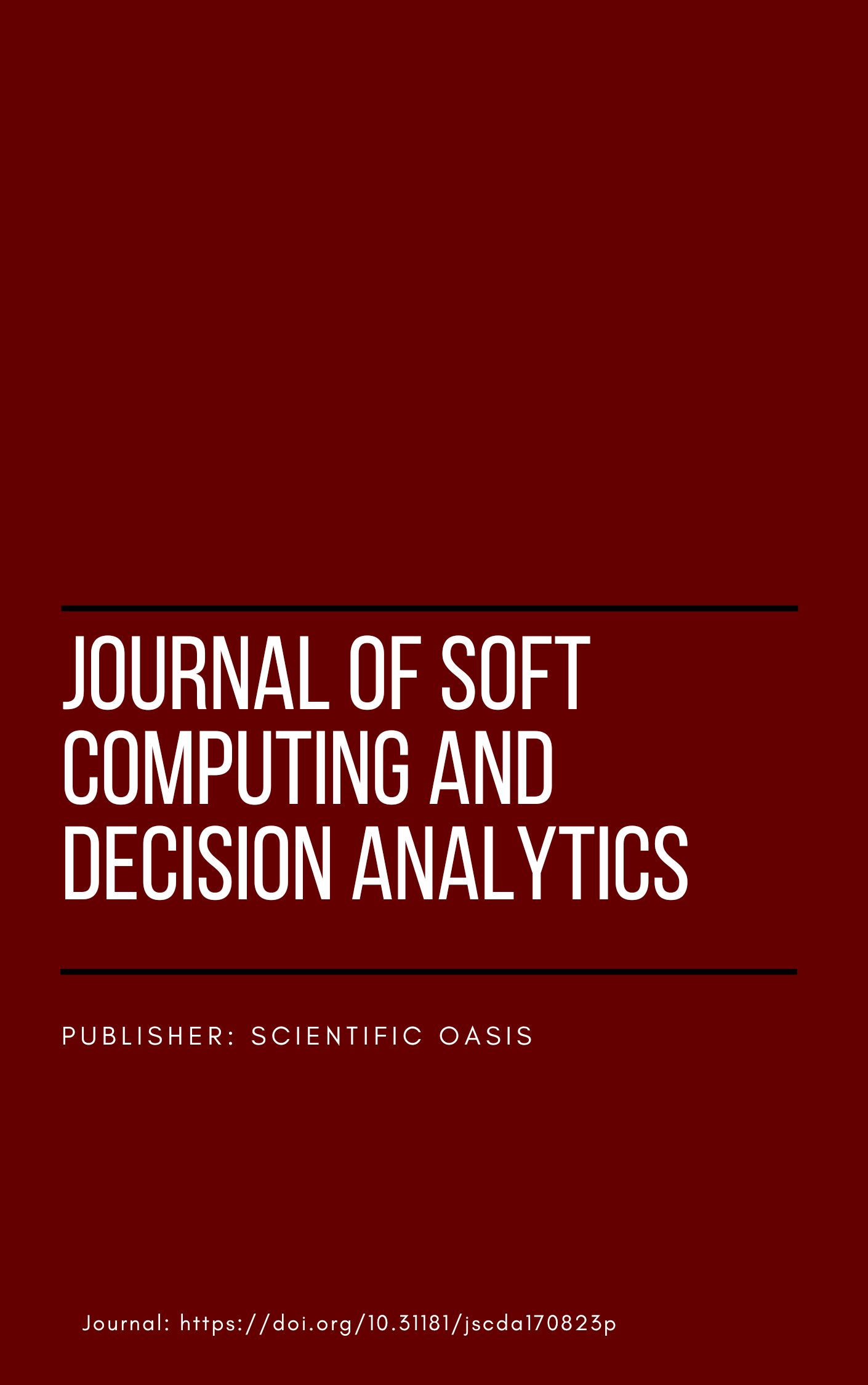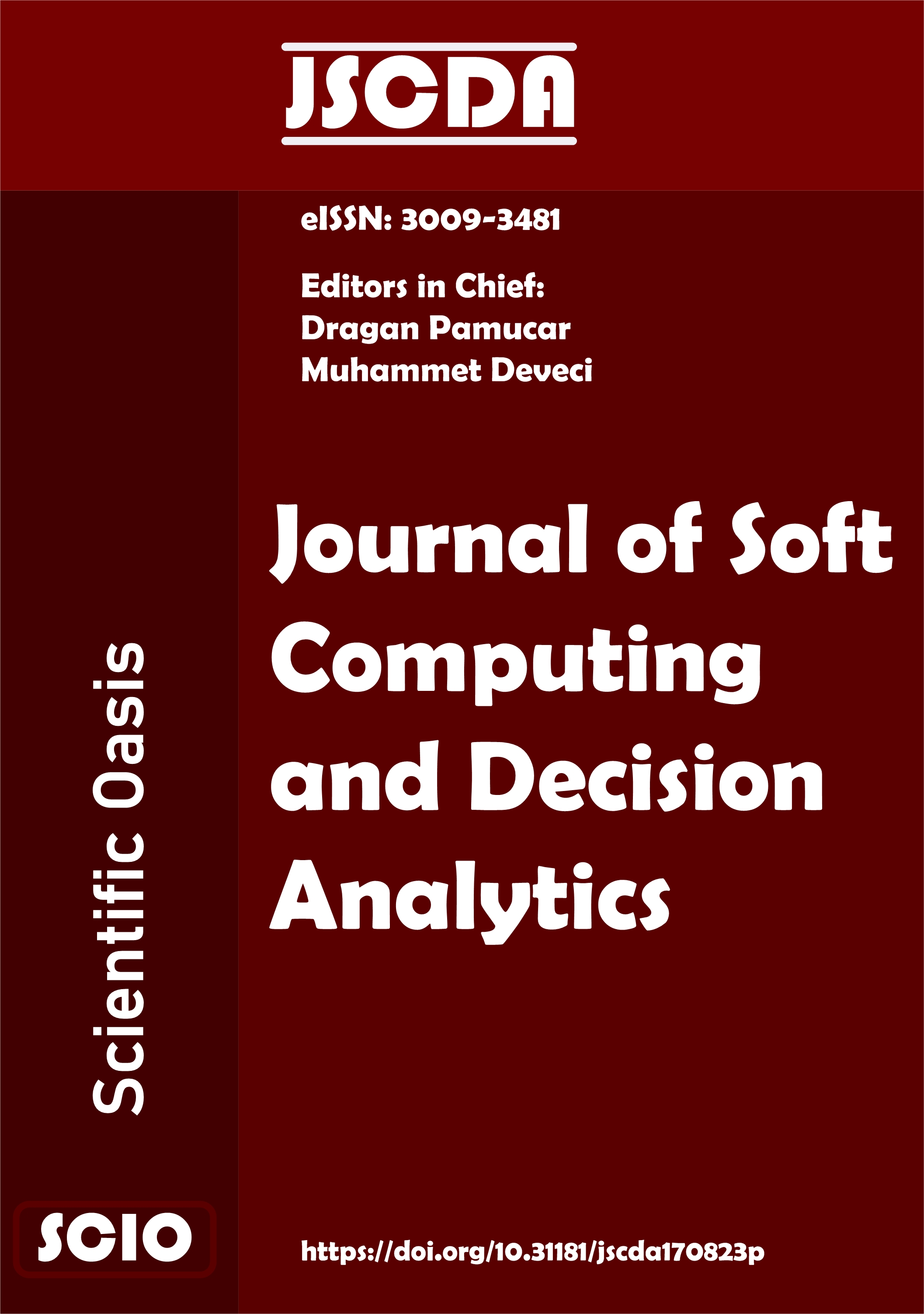Application of Pythagorean Fuzzy Analytic Hierarchy Process for Assessing Driver Behavior Criteria Associated to Road Safety
DOI:
https://doi.org/10.31181/jscda21202439Keywords:
Driver behavior criteria, Road safety, Multi Criteria Decision Making, Pythagorean Fuzzy Analytic Hierarchy Process, PrioritizingAbstract
The investigation of road safety issues has long posed a formidable challenge because of the intricate and unpredictable practice of human behavior. To address this complexity, experts in the field have turned to linguistic terms for evaluation, capitalizing on recent advancements in ordinary fuzzy sets. A promising way in Multi-criteria decision-making (MCDM) is the utilization of Pythagorean fuzzy sets (PFSs), which provide an extra flexible representation of membership tasks. This study introduces an innovative approach, the Pythagorean Fuzzy Analytic Hierarchy Process (PF-AHP), to measure and rank essential driver behavior criteria in a hierarchical model tailored for diverse driver groups in Budapest city. Our method effectively ranks the model criteria and sub-criteria based on their weighted scores. Consequently, we determine that criteria 'lapses' and 'errors' are the most pivotal factors based on the aggregated weights as compared to all other considerations. In contrast, the criterion 'disobeying speed limits' emerges as the least critical one, followed by 'disobeying overtaking rules' as the second least criterion. Our research highlights that the proposed approach yields robust and useful outcomes, well accommodating the inherent ambiguity in decision-making processes. The resilience of our findings is further affirmed through one-at-a-time sensitivity analysis.
References
World Health Organization (WHO). The Global Status Report on Road Safety 2018; WHO: Geneva, Switzerland, 2018.
Valette L. Road Safety: New Statistics Call for Fresh Efforts to Save Lives on EU Roads, European Commission Press Release: Brussels, Belgium, 2016.
EU Commission. Road Safety Facts & Figures. 2019.
OECD/ITF. Road Safety Annual Report. 2016.
National Highway Traffic Safety Administration (2008). National Motor Vehicle Crash Causation Survey. U.S. Department of Transportation: Washington, DC, USA.
Lewin, I. (1982). Driver training: A perceptual-motor skill approach. Ergonomics, 25(10), 917-24. https://doi.org/10.1080/00140138208925051
Rumar, K. (1985). The role of perceptual and cognitive filters in observed behavior. Human behavior and traffic safety, 151-170. https://doi.org/10.1007/978-1-4613-2173-6_8
de Oña, J., de Oña, R., Eboli, L., Forciniti, C., & Mazzulla, G. (2014). How to identify the key factors that affect driver perception of accident risk. A comparison between Italian and Spanish driver behavior. Accident Analysis & Prevention, 73, 225-235.. https://doi.org/10.1016/j.aap.2014.09.020
Stanton, N. A., & Salmon, P. M. (2009). Human error taxonomies applied to driving: A generic driver error taxonomy and its implications for intelligent transport systems. Safety Science, 47(2), 227-237.. https://doi.org/10.1016/j.ssci.2008.03.006
Wierwille W. W., Hanowski R. J., Hankey J. M., Kieliszewski C. A., Lee, S. E., Medina, A., Keisler, A. S & Dingus, T. A. (2002). Identification and evaluation of driver errors: overview and recommendations. U. S Department of Transportation, Federal Highway Administration, Report No. FHWA-RD-02-003.
Bifulco, G. N., Galante, F., Pariota, L., Spena, M. R., & Del Gais, P. (2014). Data collection for traffic and drivers’ behaviour studies: a large-scale survey. Procedia-social and behavioral sciences, 111, 721-730. https://doi.org/10.1016/j.sbspro.2014.01.106
Kubler, S., Robert, J., Derigent, W., Voisin, A., & Le Traon, Y. (2016). A state-of the-art survey & testbed of fuzzy AHP (FAHP) applications. Expert systems with applications, 65, 398-422. https://doi.org/10.1016/j.eswa.2016.08.064
Gul, M., Celik, E., Aydin, N., Gumus, A. T., & Guneri, A. F. (2016). A state of the art literature review of VIKOR and its fuzzy extensions on applications. Applied soft computing, 46, 60-89. https://doi.org/10.1016/j.asoc.2016.04.040
Gul, M. (2018). Application of Pythagorean fuzzy AHP and VIKOR methods in occupational health and safety risk assessment: the case of a gun and rifle barrel external surface oxidation and colouring unit. International Journal of Occupational Safety and Ergonomics (JOSE).
Arslan, O. (2009). Quantitative evaluation of precautions on chemical tanker operations. Process Safety and Environmental Protection, 87(2), 113-120. https://doi.org/10.1016/j.psep.2008.06.006
Fera, M., & Macchiaroli, R. (2010). Appraisal of a new risk assessment model for SME. Safety science, 48(10), 1361-1368. https://doi.org/10.1016/j.ssci.2010.05.009
Badri, A., Nadeau, S., & Gbodossou, A. (2012). Proposal of a risk-factor-based analytical approach for integrating occupational health and safety into project risk evaluation. Accident Analysis & Prevention, 48, 223-234. https://doi.org/10.1016/j.aap.2011.05.009
Saaty, T. L. (1990). How to make a decision: the analytic hierarchy process. European journal of operational research, 48(1), 9-26. https://doi.org/10.1016/0377-2217(90)90057-I
Farooq, D., & Moslem, S. (2019, May). A fuzzy dynamical approach for examining driver behavior criteria related to road safety. In 2019 smart city symposium Prague (SCSP) (pp. 1-7). IEEE. https://doi.org/10.1109/SCSP.2019.8805741
Farooq, D., Moslem, S., Faisal Tufail, R., Ghorbanzadeh, O., Duleba, S., Maqsoom, A., & Blaschke, T. (2020). Analyzing the importance of driver behavior criteria related to road safety for different driving cultures. International journal of environmental research and public health, 17(6), 1893. https://doi.org/10.3390/ijerph17061893
Moslem, S., Gul, M., Farooq, D., Celik, E., Ghorbanzadeh, O., & Blaschke, T. (2020). An integrated approach of best-worst method (BWM) and triangular fuzzy sets for evaluating driver behavior factors related to road safety. Mathematics, 8(3), 414. https://doi.org/10.3390/math8030414
Ilbahar, E., Karaşan, A., Cebi, S., & Kahraman, C. (2018). A novel approach to risk assessment for occupational health and safety using Pythagorean fuzzy AHP & fuzzy inference system. Safety science, 103, 124-136. https://doi.org/10.1016/j.ssci.2017.10.025
Yager, R. R. (2013, June). Pythagorean fuzzy subsets. In 2013 joint IFSA world congress and NAFIPS annual meeting (IFSA/NAFIPS) (pp. 57-61). IEEE. https://doi.org/10.1109/IFSA-NAFIPS.2013.6608375
Aminifar, S., & Marzuki, A. (2013). Uncertainty in Interval Type-2 Fuzzy Systems. Mathematical Problems in Engineering, Article ID 452780. https://doi.org/10.1155/2013/452780
Zhang, X., & Xu, Z. (2014). Extension of TOPSIS to multiple criteria decision making with Pythagorean fuzzy sets. International journal of intelligent systems, 29(12), 1061-1078. https://doi.org/10.1002/int.21676
Ali, G. B., & Atahan, O. (2020). AHP integrated TOPSIS and VIKOR methods with Pythagorean fuzzy sets to prioritize risks in self-driving vehicles. Applied Soft Computing, 99(3), 106948. https://doi.org/10.1016/j.asoc.2020.106948
Ortega, J., Tóth, J., Moslem, S., Péter, T., & Duleba, S. (2020). An Integrated Approach of Analytic Hierarchy Process and Triangular Fuzzy Sets for Analyzing the Park-and-Ride Facility Location Problem. Symmetry, 12, 1225. https://doi.org/10.3390/sym12081225
Moslem, S., & Duleba, S. (2019). Sustainable urban transport development by applying a fuzzy-AHP model: A case study from Mersin, Turkey. Urban Science, 3(2), 55. https://doi.org/10.3390/urbansci3020055
Moslem, S., Ghorbanzadeh, O., Blaschke, T., & Duleba, S. (2019). Analysing Stakeholder Consensus for a Sustainable Transport Development Decision by the Fuzzy AHP and Interval AHP. Sustainability, 11, 3271. https://doi.org/10.3390/su11123271
Dogan, O., Deveci, M., Canıtez, F., & Kahraman, C. (2020). A corridor selection for locating autonomous vehicles using an interval-valued intuitionistic fuzzy AHP and TOPSIS method. Soft Computing, 24, 8937–8953. https://doi.org/10.1007/s00500-019-04421-5
Gündoğdu, F.K., Duleba, S., Moslem, S., & Aydın, S. (2021). Evaluating public transport service quality using picture fuzzy analytic hierarchy process and linear assignment model, Applied Soft Computing, 100, 106920. https://doi.org/10.1016/j.asoc.2020.106920
Kazan, H., Çiftçi, C., & Hobikoglu, E. H. ((2015). The Fuzzy Logic for the Selection of the Transportation Type. A firm Application. Procedia - Social and Behavioral Sciences, 195, 1593 – 1601. https://doi.org/10.1016/j.sbspro.2015.06.199
Büyüközkan, G., & Göçer, F. (2018). An extension of ARAS methodology under Interval Valued Intuitionistic Fuzzy environment for Digital Supply Chain, Applied Soft Computing, 69, 634-654. https://doi.org/10.1016/j.asoc.2018.04.040
Atanassov, K. T., & Atanassov, K. T. (1999). Intuitionistic fuzzy sets (pp. 1-137). Physica-Verlag HD. https://doi.org/10.1007/978-3-7908-1870-3
Ghorbanzadeh, O., Moslem, S., Blaschke, T., & Duleba, S. (2018). Sustainable urban transport planning considering different stakeholder groups by an interval-AHP decision support model. Sustainability, 11(1), 9. https://doi.org/10.3390/su11010009
Pérez-Dominguez, L., Durán, S. N. A., López, R. R., Pérez-Olguin, I. J. C., Luviano-Cruz, D., & Gómez, J. A. H. (2021). Assessment urban transport service and Pythagorean Fuzzy Sets CODAS method: A case of study of Ciudad Juárez. Sustainability, 13(3), 1281. https://doi.org/10.3390/su13031281
Wang, G., Tao, Y., & Li, Y. (2020). TOPSIS evaluation system of logistics transportation based on an ordered representation of the polygonal fuzzy set. International Journal of Fuzzy systems, 22, 1565-1581. https://doi.org/10.1007/s40815-020-00861-6
Farooq, D., & Moslem, S. (2022). Estimating driver behavior measures related to traffic safety by investigating 2-dimensional uncertain linguistic data—a pythagorean fuzzy analytic hierarchy process approach. Sustainability, 14(3), 1881. https://doi.org/10.3390/su14031881
Peng, X., & Yang, Y. (2015). Some results for Pythagorean fuzzy sets. International Journal of Intelligent Systems, 30(11), 1133-1160. https://doi.org/10.1002/int.21738
Zhang, X. (2016). Multicriteria Pythagorean fuzzy decision analysis: A hierarchical QUALIFLEX approach with the closeness index-based ranking methods. Information Sciences, 330, 104-124. https://doi.org/10.1016/j.ins.2015.10.012
Af Wåhlber, A., Dorn, L., & Kline, T. (2011). The Manchester driver behavior questionnaire as a predictor of road traffic accidents. Theoretical Issues in Ergonomics Science, 12, 66-86. https://doi.org/10.1080/14639220903023376
De Winter J. C. F., & Dodou, D. (2010). The Driver Behavior Questionnaire as a predictor of accidents: A meta-analysis. Journal of Safety Research, 41(6), 463-470. https://doi.org/10.1016/j.jsr.2010.10.007
Parker D., Manstead A. S. R., & Stradling, S. G. (1995). Extending the theory of planned behavior: The role of personal norm. British journal of social psychology, 34, 127-137. https://doi.org/10.1111/j.2044-8309.1995.tb01053.x
Reason J. T., Manstead A. S. R., Stradling S., Baxter J., & Campbell, K. (1990). Errors and violations on the roads. Ergonomics, 33, 1315-1332. https://doi.org/10.1080/00140139008925335
Farooq, D., Moslem, S., & Duleba, S. (2019). Evaluation of Driver Behavior Criteria for Evolution of Sustainable Traffic Safety. Sustainability, 11, 3142. https://doi.org/10.3390/su11113142
Karlaftis, M. G., & Golias, I. (2002). Effects of road geometry and traffic volumes on rural roadway accident rates. Accident Analysis and Prevention, 34, 357-365. https://doi.org/10.1016/S0001-4575(01)00033-1
Bener, A., & Crundall, D. (2008). Effects of driver behavior on accident involvement: The role of gender and driver behavior in Road Traffic Crashes. International Journal of Crashworthiness, 13(3), 331-336. https://doi.org/10.1080/13588260801942684
De Oña, J., De Oña, R., Eboli, L., Forciniti, C., & Mazzulla, G. (2014). How to identify the key factors that affect driver perception of accident risk. A comparison between Italian and Spanish driver behavior. Accident Analysis and Prevention, 73, 225-235. https://doi.org/10.1016/j.aap.2014.09.020
Lajunen, T., Parker, D., & Summala, H. (2004). The Manchester Driver Behavior Questionnaire: a cross-cultural study. Accident Analysis and Prevention, 36(2), 231-8. https://doi.org/10.1016/S0001-4575(02)00152-5
Lawton, R., Parker, D., Stradling, S. G., & Manstead A. S. R. (1997). Predicting road traffic accidents: The role of social deviance and violations, British Journal of Psychology, 88(2), 249-262. https://doi.org/10.1111/j.2044-8295.1997.tb02633.x
Downloads
Published
Issue
Section
License
Copyright (c) 2024 Scientific Oasis

This work is licensed under a Creative Commons Attribution-NonCommercial-NoDerivatives 4.0 International License.
















